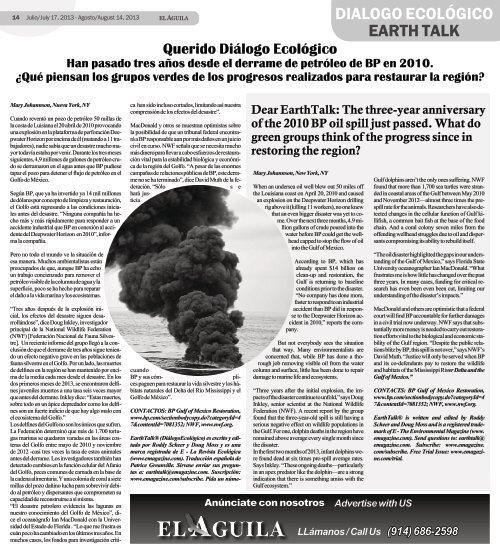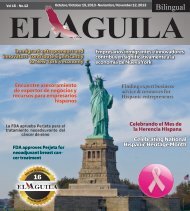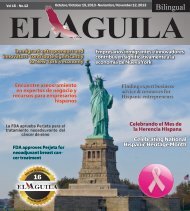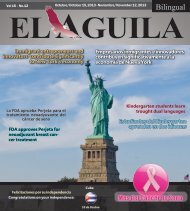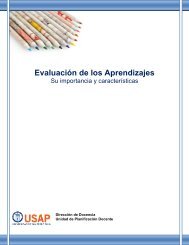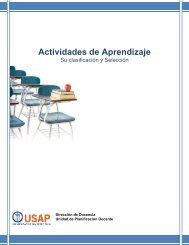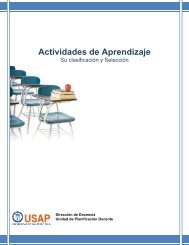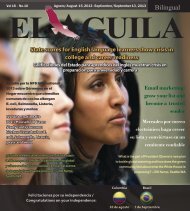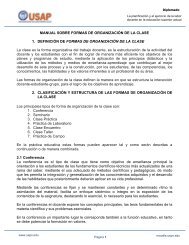DIGITAL EDITION 17 JULIO
You also want an ePaper? Increase the reach of your titles
YUMPU automatically turns print PDFs into web optimized ePapers that Google loves.
14 Julio/July <strong>17</strong>, 2013 - Agosto/August 14, 2013<br />
EL AGUILA<br />
Querido Diálogo Ecológico<br />
Han pasado tres años desde el derrame de petróleo de BP en 2010.<br />
¿Qué piensan los grupos verdes de los progresos realizados para restaurar la región?<br />
Mary Johannson, Nueva York, NY<br />
Cuando reventó un pozo de petróleo 50 millas de<br />
la costa de Luisiana el 20 abril de 2010 provocando<br />
una explosión en la plataforma de perforación Deepwater<br />
Horizon por encima de él (matando a 11 trabajadores),<br />
nadie sabía que un desastre mucho mayor<br />
todavía estaba por venir. Durante los tres meses<br />
siguientes, 4,9 millones de galones de petróleo crudo<br />
se derramaron en el agua antes que BP pudiese<br />
tapar el pozo para detener el flujo de petróleo en el<br />
Golfo de México.<br />
Según BP, que ya ha invertido ya 14 mil millones<br />
de dólares por concepto de limpieza y restauración,<br />
el Golfo está regresando a las condiciones iniciales<br />
antes del desastre. “Ninguna compañía ha hecho<br />
más y más rápidamente para responder a un<br />
accidente industrial que BP en conexión al accidente<br />
del Deepwater Horizon en 2010”, informa<br />
la compañía.<br />
Pero no todo el mundo ve la situación de<br />
esa manera. Muchos ambientalistas están<br />
preocupados de que, aunque BP ha echo<br />
un trabajo concienzudo para remover el<br />
petróleo visible de la columna de agua y la<br />
superficie, poco se ha hecho para reparar<br />
el daño a la vida marina y los ecosistemas.<br />
“Tres años después de la explosión inicial,<br />
los efectos del desastre siguen desarrollándose”,<br />
dice Doug Inkley, investigador<br />
principal de la National Wildlife Federation<br />
(NWF) [Federación Nacional de Fauna Silvestre].<br />
Un reciente informe del grupo llegó a la conclusión<br />
de que el derrame de tres años sigue teniendo<br />
un efecto negativo grave en las poblaciones de<br />
fauna silvestre en el Golfo. Por un lado, las muertes<br />
de delfines en la región se han mantenido por encima<br />
de la media cada mes desde el desastre. En los<br />
dos primeros meses de 2013, se encontraron delfines<br />
juveniles muertos a una tasa seis veces mayor<br />
que antes del derrame. Inkley dice: “Estas muertes,<br />
sobre todo en un ápice depredador como los delfines<br />
son un fuerte indicio de que hay algo malo con<br />
el ecosistema del Golfo.”<br />
Los delfines del Golfo no son los únicos que sufren.<br />
La Federación determinó que más de 1.700 tortugas<br />
marinas se quedaron varadas en las áreas costeras<br />
del Golfo entre mayo de 2010 y noviembre<br />
de 2012 -casi tres veces la tasa de estos animales<br />
antes del derrame. Los investigadores también han<br />
detectado cambios en la función celular del Afanio<br />
del Golfo, peces comunes de carnada en la base de<br />
la cadena alimentaria. Y una colonia de coral a siete<br />
millas del pozo dañino lucha para sobrevivir debido<br />
al petróleo y dispersantes que comprometen su<br />
capacidad de reconstruirse a sí misma.<br />
“El desastre petrolero evidencia las lagunas en<br />
nuestro conocimiento del Golfo de México”, dice<br />
el oceanógrafo Ian MacDonald con la Universidad<br />
del Estado de Florida . “Lo que me frustra es<br />
cuán poco ha cambiado en los últimos tres años. En<br />
muchos casos, los fondos para investigación críti-<br />
ca han sido incluso cortados, limitando así nuestra<br />
comprensión de los efectos del desastre”.<br />
MacDonald y otros se muestran optimistas sobre<br />
la posibilidad de que un tribunal federal encontrará<br />
a BP responsable aun por más daños en un juicio<br />
civil en curso. NWF señala que se necesita mucho<br />
más dinero para llevar a cabo esfuerzos de restauración<br />
vital para la estabilidad biológica y económica<br />
de la región del Golfo. “A pesar de las enormes<br />
campañas de relaciones públicas de BP, este derrame<br />
no se ha terminado”, dice David Muth de la federación.<br />
“Sólo s e<br />
hará justicia<br />
cuando<br />
BP y sus cóm- plices<br />
paguen para restaurar la vida silvestre y los hábitats<br />
naturales del Delta del Río Mississippi y el<br />
Golfo de México”.<br />
CONTACTOS: BP Gulf of Mexico Restoration,<br />
www.bp.com/sectionbodycopy.do?categoryId=4<br />
7&contentId=7081352; NWF, www.nwf.org.<br />
EarthTalk® (DiálogoEcológico) es escrito y editado<br />
por Roddy Scheer y Doug Moss y es una<br />
marca registrada de E - La Revista Ecológica<br />
(www.emagazine.com). Traducción española de<br />
Patrice Greanville. Sírvase enviar sus preguntas<br />
a: earthtalk@emagazine.com. Suscripción:<br />
www.emagazine.com/subscribe. Pida un núme-<br />
Mary Johannson, New York, NY<br />
When an undersea oil well blew out 50 miles off<br />
the Louisiana coast on April 20, 2010 and caused<br />
an explosion on the Deepwater Horizon drilling<br />
rig above it (killing 11 workers), no one knew<br />
that an even bigger disaster was yet to come.<br />
Over the next three months, 4.9 million<br />
gallons of crude poured into the<br />
water before BP could get the wellhead<br />
capped to stop the flow of oil<br />
into the Gulf of Mexico.<br />
According to BP, which has<br />
already spent $14 billion on<br />
clean-up and restoration, the<br />
Gulf is returning to baseline<br />
conditions prior to the disaster.<br />
“No company has done more,<br />
faster to respond to an industrial<br />
accident than BP did in response<br />
to the Deepwater Horizon accident<br />
in 2010,” reports the company.<br />
But not everybody sees the situation<br />
that way. Many environmentalists are<br />
concerned that, while BP has done a thorough<br />
job removing visible oil from the water<br />
column and surface, little has been done to repair<br />
damage to marine life and ecosystems.<br />
“Three years after the initial explosion, the impacts<br />
of the disaster continue to unfold,” says Doug<br />
Inkley, senior scientist at the National Wildlife<br />
Federation (NWF). A recent report by the group<br />
found that the three-year-old spill is still having a<br />
serious negative effect on wildlife populations in<br />
the Gulf. For one, dolphin deaths in the region have<br />
remained above average every single month since<br />
the disaster.<br />
In the first two months of 2013, infant dolphins were<br />
found dead at six times pre-spill average rates.<br />
Says Inkley. “These ongoing deaths—particularly<br />
in an apex predator like the dolphin—are a strong<br />
indication that there is something amiss with the<br />
Gulf ecosystem.”<br />
DIALOGO ECOLÓGICO<br />
EARTH TALK<br />
Dear EarthTalk: The three-year anniversary<br />
of the 2010 BP oil spill just passed. What do<br />
green groups think of the progress since in<br />
restoring the region?<br />
Anúnciate con nosotros Advertise with US<br />
Gulf dolphins aren’t the only ones suffering. NWF<br />
found that more than 1,700 sea turtles were stranded<br />
in coastal areas of the Gulf between May 2010<br />
and November 2012—almost three times the prespill<br />
rate for the animals. Researchers have also detected<br />
changes in the cellular function of Gulf killifish,<br />
a common bait fish at the base of the food<br />
chain. And a coral colony seven miles from the<br />
offending wellhead struggles due to oil and dispersants<br />
compromising its ability to rebuild itself.<br />
“The oil disaster highlighted the gaps in our understanding<br />
of the Gulf of Mexico,” says Florida State<br />
University oceanographer Ian MacDonald. “What<br />
frustrates me is how little has changed over the past<br />
three years. In many cases, funding for critical research<br />
has even been even been cut, limiting our<br />
understanding of the disaster’s impacts.”<br />
MacDonald and others are optimistic that a federal<br />
court will find BP accountable for further damages<br />
in a civil trial now underway. NWF says that substantially<br />
more money is needed to carry out restoration<br />
efforts vital to the biological and economic stability<br />
of the Gulf region. “Despite the public relations<br />
blitz by BP, this spill is not over,” says NWF’s<br />
David Muth. “Justice will only be served when BP<br />
and its co-defendants pay to restore the wildlife<br />
and habitats of the Mississippi River Delta and the<br />
Gulf of Mexico.”<br />
CONTACTS: BP Gulf of Mexico Restoration,<br />
www.bp.com/sectionbodycopy.do?categoryId=4<br />
7&contentId=7081352; NWF, www.nwf.org.<br />
EarthTalk® is written and edited by Roddy<br />
Scheer and Doug Moss and is a registered trademark<br />
of E - The Environmental Magazine (www.<br />
emagazine.com). Send questions to: earthtalk@<br />
emagazine.com. Subscribe: www.emagazine.<br />
com/subscribe. Free Trial Issue: www.emagazine.com/trial.<br />
LLámanos / Call Us (914) 686-2598


